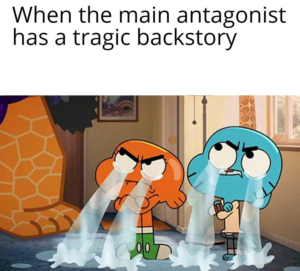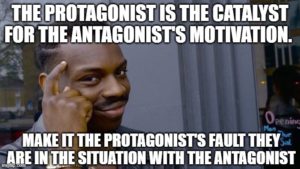How to write a great villain?
Creating a great villain is essential to any good story. A strong antagonist provides tension, stakes, and excitement that will keep your readers engaged and invested in the narrative. It can be difficult to craft a compelling bad guy who is both menacing and believable at the same time, but with some practice, you can make sure your villains become as iconic as your heroes. In this blog post, we’ll look at how to create an unforgettable villain for your story – from constructing their backstory to adding unique layers of complexity – so you can have a truly captivating antagonist who will bring out the best in all of your characters. So let’s dive right in and learn how to write a great villain!
- Why do good stories need a great villain?
- Start with the motivations and goals of your villain
- Reflect on what makes them relatable despite being an antagonist
- Create a compelling backstory for your villain
- Create a vivid physical persona of your villain
- Establish a unique voice for your villain to make them memorable
- Make sure the villain’s actions are believable yet surprising
- Give them strengths and weaknesses that will challenge the protagonist in interesting ways
- Consider how they interact with other characters in the story
- Showcase their impact on the plot through powerful moments or decisions they make throughout the story
- The Villain’s Journey
- Common mistakes to avoid when writing a villain
- A look at some of the greatest villains in literature
- Tips to remember when writing your villain
Why do good stories need a great villain?
Good stories need great villains to be truly compelling and captivate their readers. Villains provide the necessary complexity and contrast to further explore good and evil, as well as add depth and dimension to what would otherwise be a black-and-white narrative.
Great villains are deliberately crafted with personalities that challenge a protagonist’s journey, but also offer layers of intricacy in the form of motivations and backgrounds that drive their actions.
Additionally, a good antagonist forces us to look for value on both sides of the issue, which helps readers evaluate beliefs from multiple perspectives. By making good stories better through this more intentional process, great villains have an essential role in elevating storytelling and its impact to inspiring new levels.
Start with the motivations and goals of your villain
When starting to write your antagonist, your first step should be to define their motivations and goals. This will provide your narrative with consistency, allowing your readers to understand the intent behind your antagonist’s choices. It is important to remember that your antagonist doesn’t need to be bad all the time – in fact, adding an interesting twist by revealing some of their motivations can change your readers’ perception of your antagonist and make them even more compelling!

After you have determined your antagonist’s motivations and goals, the next step is to reveal them in interesting ways throughout your story. Whether it be through interactions or a powerful revelation at the climax, do not hesitate to get creative with how your audience finds out what drives your antagonist. Doing this will create deeper connections between your characters and help bring your story to life.
Reflect on what makes them relatable despite being an antagonist
Incorporating antagonists into a narrative is essential for telling any meaningful story. But simply making an antagonist a villain who exists to oppose the protagonist isn’t enough; reflecting on what makes them relatable despite being a villain can add an extra layer of richness and humanity to your overall narrative that sets your storytelling apart.
Doing this avoids creating antagonists who feel shallow and superfluous, conveying instead characters with unique qualities and complexities that readers or audience members can relate to on some level, understand better, and empathize with.
Developing those details—by exploring antagonists’ motivations, backstories, and values at odds with the protagonist—can add depth and allow readers or audience members to evaluate antagonists more holistically.
When antagonists are made more relatable it enriches our reading experience as we gain an understanding of how antagonists become villains in the first place and why they behave as they do.
Create a compelling backstory for your villain
Crafting a compelling antagonist is an essential part of creating a captivating narrative. The best villains all have a story – an origin story that helps explain to the reader why they’re doing what they’re doing and how they became who they are.
Pointers to craft the origin story of your villain:
Crafting the backstory can be broken down into steps that form the foundation for your antagonist:
First, explore their life before your narrative began. What do their past experiences say about their current motivations? Second, consider what event or event set them on a path to becoming the antagonist in your story.

Third, look at their personal goals; these should hook into your antagonist’s backstory and help propel them forward through the plot. Lastly, think about how this relates to the overall arc of your villain’s journey – what will make it satisfying not just for readers but for your antagonist as well?
Taking time to craft a compelling backstory can help provide motivation, purpose, and individuality to your antagonist — something that will elevate any narrative.
Create a vivid physical persona of your villain
Creating a vivid physical persona for your writing’s antagonist helps build an impactful narrative. Physical representations of antagonists can be used to build suspense and give depth to the story. To make the character come alive, think of their features, mannerisms, and facial expressions.
Details like eye color or body language are small but powerful ways to bring your writing’s villain to life. In addition, consider how these details have influenced their behavior.
If a character has an arguably attractive appearance, this could shape how people including other characters react toward them in the book or story. All in all, writing authentic antagonists with multifaceted characteristics is key in creating a story that readers will remember and engage with long after they’ve finished reading it.
Establish a unique voice for your villain to make them memorable
Establishing a unique voice for your villain is one of the most important writing techniques you need to master as a storyteller. It’s essential for crafting an interesting, complex antagonist that will leave readers dying to find out their next move.
Creating a distinct and memorable voice for your villain will help bring them to life in all their evil glory, and make them impossible to forget – plus, it will have the added bonus of making any conflicts between the protagonist and the antagonist more captivating.
Writing effective dialogue and descriptive passages about your villain’s personality traits, mannerisms, and attitude are great places to start when creating a one-of-a-kind voice for them in your writing. Crafting stand-out dialogue gives you a chance to reveal truths or details about your villain’s backstory that contribute towards giving them a unique voice that stays with readers well after they turn the last page of your book.
Make sure the villain’s actions are believable yet surprising
When writing your antagonist, it is essential to create believable yet surprising actions. To create a more credible and greater impact on your readers, you should focus on writing realistic reactions for the villain that make sense in the story.
Furthermore, expect these reactions to take unexpected turns; if audiences can guess what will come next, the tension will be deflated.
Make sure that with every action, the motivations of your villain are clear; while they should still surprise readers at times, their decisions must be grounded in logic. In this way, readers will always stay engaged and understand why each choice was made. Writing a believable yet unpredictable villain is the key to making an unforgettable antagonist and captivating story.
Give them strengths and weaknesses that will challenge the protagonist in interesting ways
When writing your antagonist, it’s important to consider including both strengths and weaknesses. These strengths should naturally challenge your protagonist in interesting ways, pushing them out of their comfort zone. Your antagonist’s weaknesses can be a counterpoint to the protagonist’s strengths and provide steep challenges for overcoming.

Adding these contrasting qualities creates an interesting dynamic between the two characters which will contribute to the overall central conflict of the protagonist vs the antagonist.
Of course, writing a compelling antagonist also requires other storytelling elements such as giving him motivations, and goals, and subjecting him to meaningful arcs within the story – all of which work together with their strengths and weaknesses to build up an interesting fight for power against the protagonist.
Consider how they interact with other characters in the story
When crafting a story, the villains and their interactions with other characters need to be carefully thought out in order to create interesting conflicts. Developing unique personalities for villains can be key in creating tension between them and other characters in your story.
Whether it be via dialogue, body language, or physical actions like aggression/aggravation, each villain should interact differently depending on whom they’re laying up against.
This variability allows these interactions to be essential leverage points when bringing an atmosphere and tone of conflict into the story. In short, how you carefully craft how each villain interacts with their surroundings can profoundly impact your storytelling and further engage your readers by providing them with a convincing reason why there’s strife among the characters in the play.
Showcase their impact on the plot through powerful moments or decisions they make throughout the story
Villains and antagonists with an impact on your plot can elevate your narrative to the next level, compelling readers to keep reading. By building powerful moments into your villains’ arcs throughout the story, you create a dynamic and unique relationship between your villains and the plot.
Concentrate on the decisions villains makes at key plot points that disrupt the normal flow of events, or decisions that have unexpected outcomes. This grabs the reader’s attention and heightens their investment in both the villains and their overall journey within your narrative framework. Ultimately, showcasing villains’ influence is an effective way to keep readers engrossed in your story every step of the way.
The Villain’s Journey
The villain’s journey shares similar characteristics to the hero’s journey, first proposed by scholar Joseph Campbell in his idea of the monomyth. These journeys differ as they focus on different aspects of two varied character arcs.
At the beginning of a villain’s journey, they enter with selfish goals and struggle to gain power and authority in order to satisfy their wants above all else.
As they progress through their story, villains usually face a great challenge or adversary that tests the villain’s morals and strength, eventually culminating in their eventual downfall at the end.
This reveals the villain’s life choices are unsustainable and unsustainable, often leading them to suffer consequences before ultimately returning to equilibrium by accepting responsibility for their actions and recognizing their villainous behavior was not effective in getting what they wanted. This type of narrative emphasizes cause-and-effect thinking, as well as themes of morality and ethics—principles that are essential for understanding both villainous arcs and hero’s journeys alike.
Common mistakes to avoid when writing a villain
Writing a great villain is an essential part of writing a compelling story, yet it can be a challenge for many writers. To create a fully formed villain that readers connect with, there are some common mistakes that writers should work hard to avoid.
A primary mistake is writing a villain without a logical goal that contrasts the protagonist.
This makes it difficult to understand why the villain behaves in certain ways because, without well-developed motivations and goals, it appears as simply irrational.
Additionally, writing villains who lack depth or subtlety can make them seem one-dimensional and uninteresting. By designing their villain with unique and sometimes unexpected traits, writers can immerse their audience into the story and ensure their antagonist stands out in the story.
When writing a villain, remember to give them thoughtfulness and layers: these are important elements in crafting an antagonist readers care about.
A look at some of the greatest villains in literature
Crafting a successful villain is arguably one of the most crucial elements of writing any type of story. Many of the greatest villains have become iconic characters, not solely due to their horrors and hatred, but also thanks to their fascinating complexities. Think as far back as Shakespeare’s Richard III—a king driven by ambition, fear, and paranoia—or Milton’s Satan from Paradise Lost—a fallen angel whose very identity was stolen from him in a single moment and whose single-minded thirst for revenge drives him through hell and beyond.

More modern examples include Lord Voldemort from the Harry Potter series–an incredibly powerful wizard with a clear set of rules that he sticks to without fail–and Heathcliff from Wuthering Heights, who becomes so twisted by love that he seeks vengeance against those who wronged him despite his own suffering. It is these characters who show writers what writing a truly captivating antagonist truly looks like: an individual with not just flaws and delusions but motivations, drives, goals, and ambitions which push them outside of mere evilness. It’s no wonder they live on long after readers have put their books down.
Tips to remember when writing your villain
Writing a villain can often be one of the toughest parts of creating a story. It’s not enough for them to simply be the opposite of the protagonist – they should add depth and intrigue to your world. To help you write an engaging antagonist, there are a few crucial tips to remember.

Firstly, strive to give your villain a clear motivation behind their deeds. Whether it’s revenge or simply power-hungry ambition, their actions should make sense within the story’s context; this will especially help in making them interesting to readers. Secondly, don’t be afraid to give your villain some desirable traits – that way they won’t seem 2-dimensional or cliched.
Lastly, establish if there is any redeemable quality in your villain: do they have hidden moments of tenderness? An unexpectedly strong sense of justice? All these details will come together in fashioning an unforgettable antagonist that stands out from traditional evil villains.
